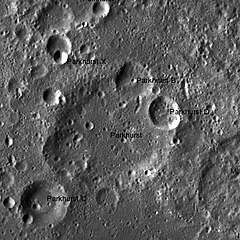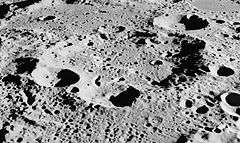Parkhurst (crater)
Parkhurst is a heavily degraded lunar impact crater to the northeast of the Mare Australe on the far side of the Moon. To the north-northeast of Parkhurst is the crater Scaliger and to the southwest lies the dark-floored Gernsback. The small lunar mare named Lacus Solitudinis lies due north of Parkhurst.
 LRO WAC image | |
| Coordinates | 33.4°S 103.6°E |
|---|---|
| Diameter | 96 km |
| Depth | Unknown |
| Colongitude | 258° at sunrise |
| Eponym | John A. Parkhurst |

Little remains of this crater formation other than the uneven outline of the outer rim. Several satellite craters lie along the rim edge, with Parkhust D along the northeast, B to the north, and X along the northwest. The satellite crater Parkhurst Q pushes into the southwestern rim, distorting the edge shape. The interior floor of Parkhurst is pock-marked by small craterlets.
Satellite craters
By convention these features are identified on lunar maps by placing the letter on the side of the crater midpoint that is closest to Parkhurst.
| Parkhurst | Latitude | Longitude | Diameter |
|---|---|---|---|
| B | 32.0° S | 104.4° E | 30 km |
| D | 32.8° S | 105.4° E | 27 km |
| K | 36.3° S | 105.2° E | 11 km |
| Q | 35.0° S | 101.6° E | 37 km |
| X | 31.5° S | 102.3° E | 12 km |
| Y | 29.9° S | 102.8° E | 49 km |
References
- Andersson, L. E.; Whitaker, E. A. (1982). NASA Catalogue of Lunar Nomenclature. NASA RP-1097.CS1 maint: ref=harv (link)
- Blue, Jennifer (July 25, 2007). "Gazetteer of Planetary Nomenclature". USGS. Retrieved 2007-08-05.CS1 maint: ref=harv (link)
- Bussey, B.; Spudis, P. (2004). The Clementine Atlas of the Moon. New York: Cambridge University Press. ISBN 978-0-521-81528-4.CS1 maint: ref=harv (link)
- Cocks, Elijah E.; Cocks, Josiah C. (1995). Who's Who on the Moon: A Biographical Dictionary of Lunar Nomenclature. Tudor Publishers. ISBN 978-0-936389-27-1.CS1 maint: ref=harv (link)
- McDowell, Jonathan (July 15, 2007). "Lunar Nomenclature". Jonathan's Space Report. Retrieved 2007-10-24.CS1 maint: ref=harv (link)
- Menzel, D. H.; Minnaert, M.; Levin, B.; Dollfus, A.; Bell, B. (1971). "Report on Lunar Nomenclature by the Working Group of Commission 17 of the IAU". Space Science Reviews. 12 (2): 136–186. Bibcode:1971SSRv...12..136M. doi:10.1007/BF00171763.CS1 maint: ref=harv (link)
- Moore, Patrick (2001). On the Moon. Sterling Publishing Co. ISBN 978-0-304-35469-6.CS1 maint: ref=harv (link)
- Price, Fred W. (1988). The Moon Observer's Handbook. Cambridge University Press. ISBN 978-0-521-33500-3.CS1 maint: ref=harv (link)
- Rükl, Antonín (1990). Atlas of the Moon. Kalmbach Books. ISBN 978-0-913135-17-4.CS1 maint: ref=harv (link)
- Webb, Rev. T. W. (1962). Celestial Objects for Common Telescopes (6th revised ed.). Dover. ISBN 978-0-486-20917-3.CS1 maint: ref=harv (link)
- Whitaker, Ewen A. (1999). Mapping and Naming the Moon. Cambridge University Press. ISBN 978-0-521-62248-6.CS1 maint: ref=harv (link)
- Wlasuk, Peter T. (2000). Observing the Moon. Springer. ISBN 978-1-85233-193-1.CS1 maint: ref=harv (link)